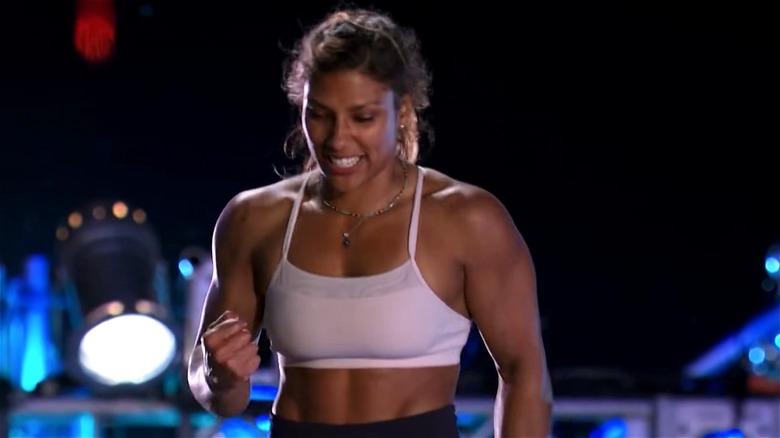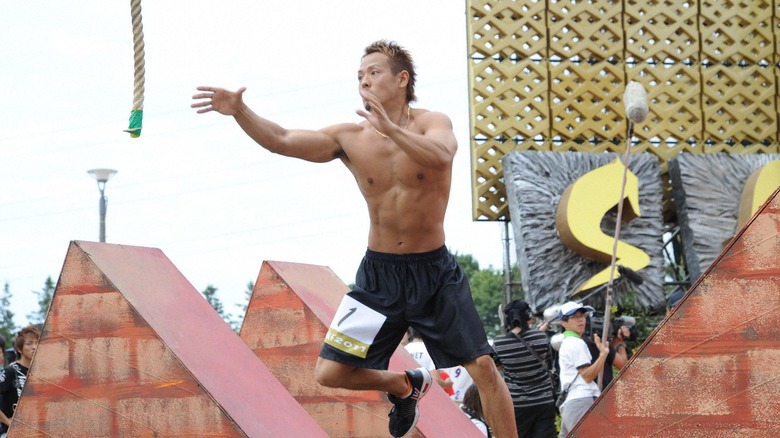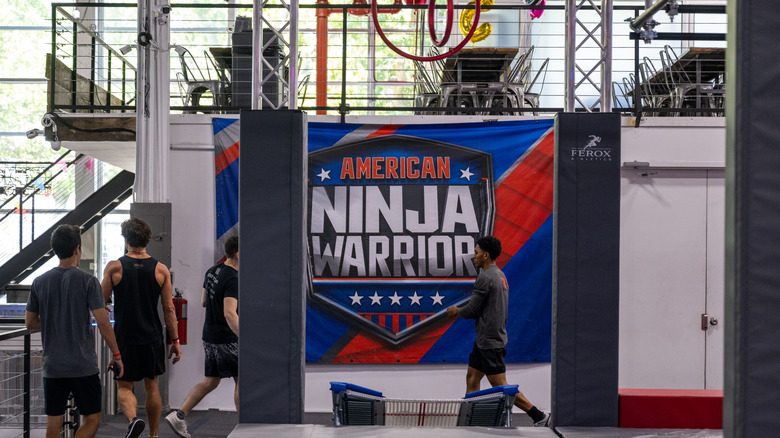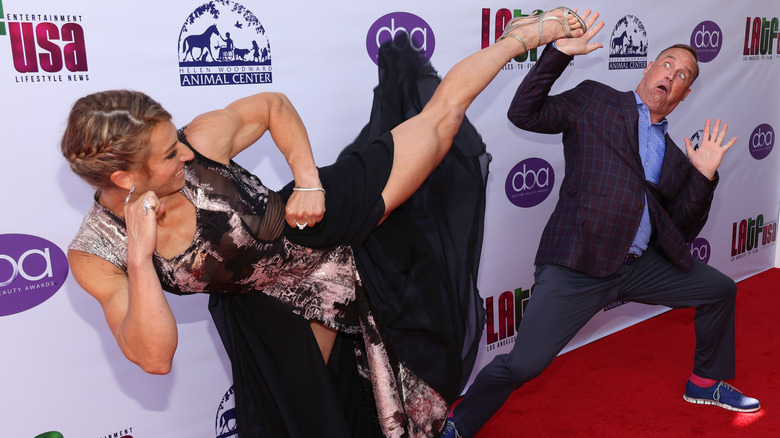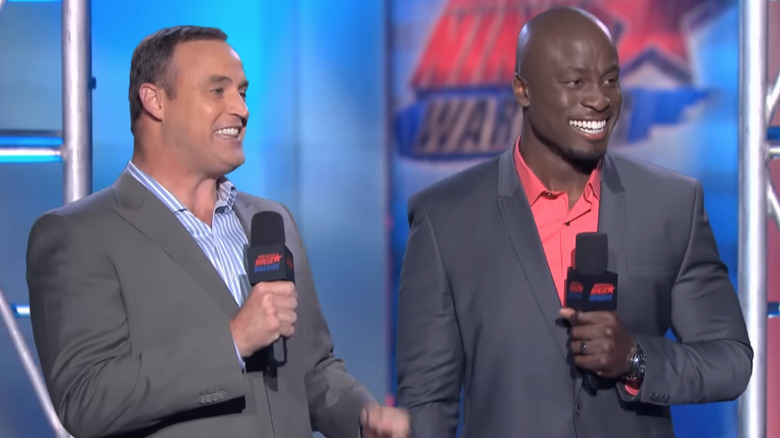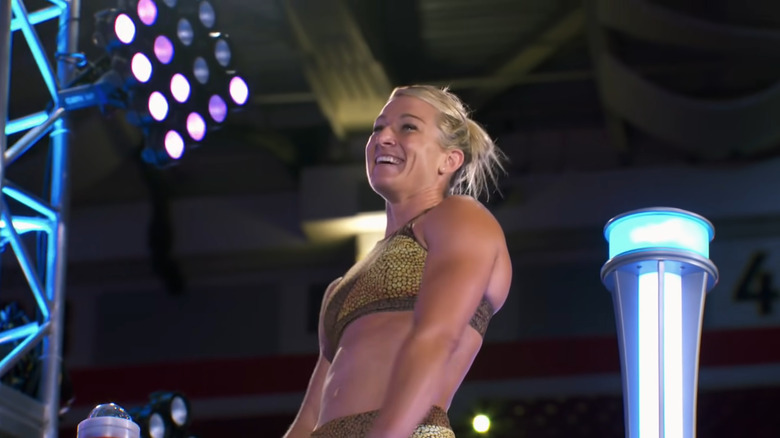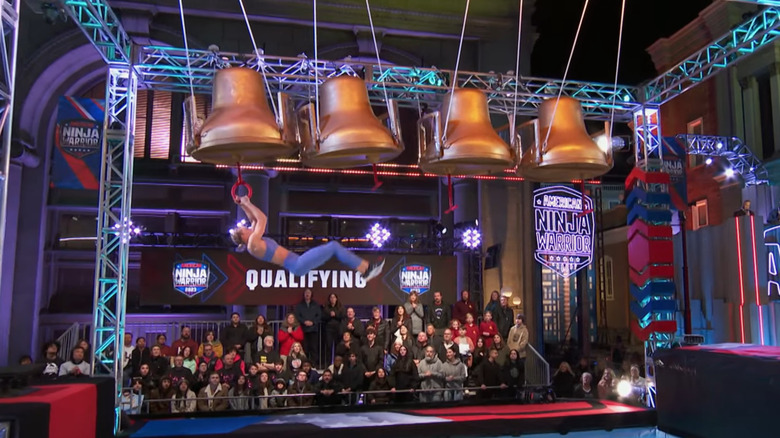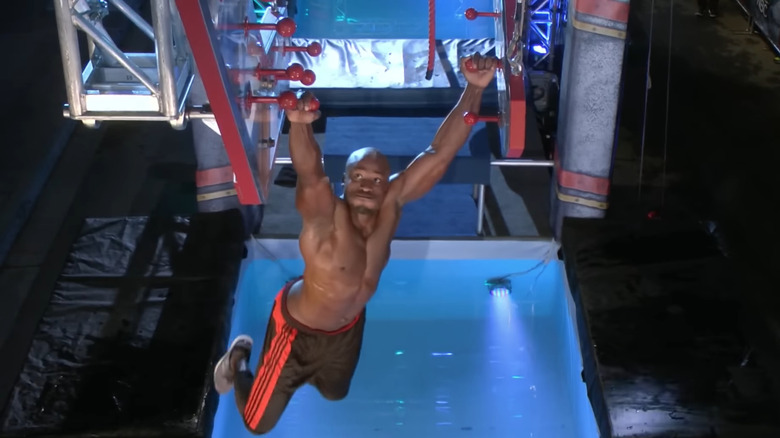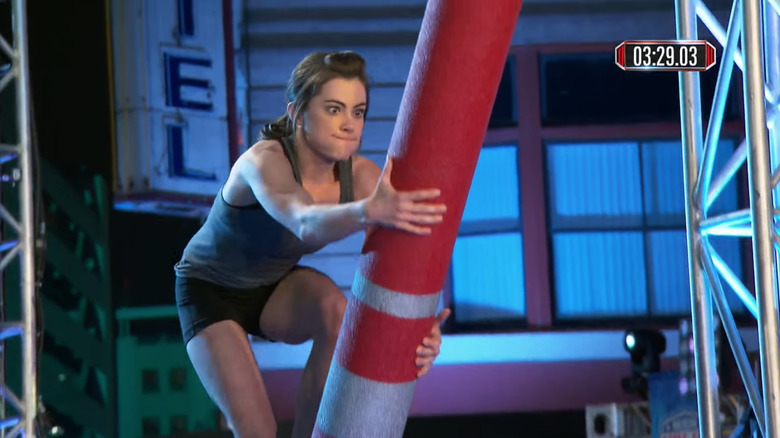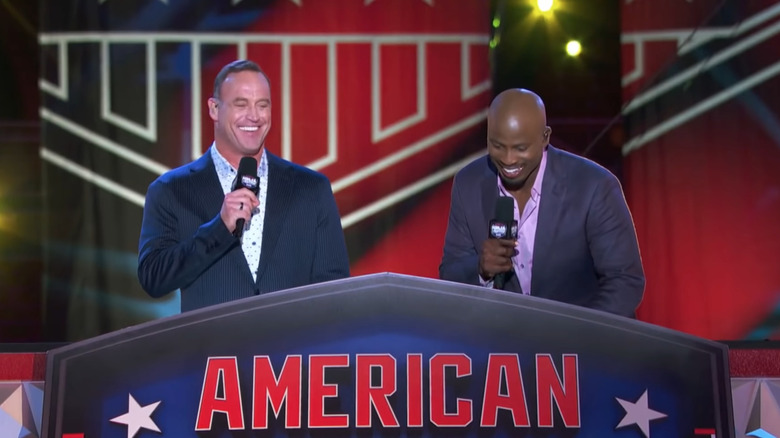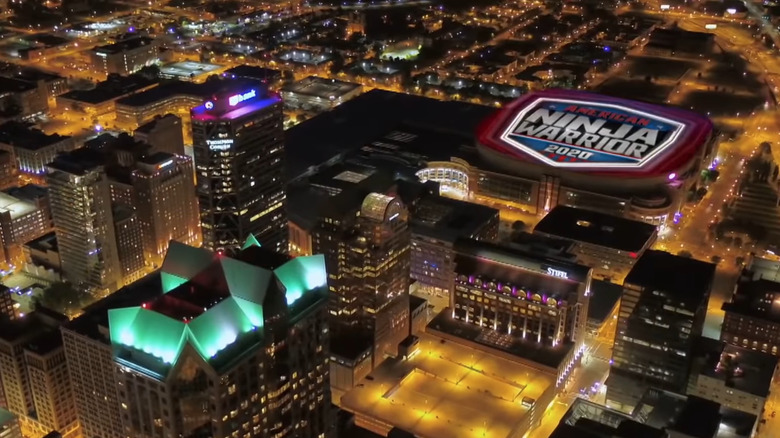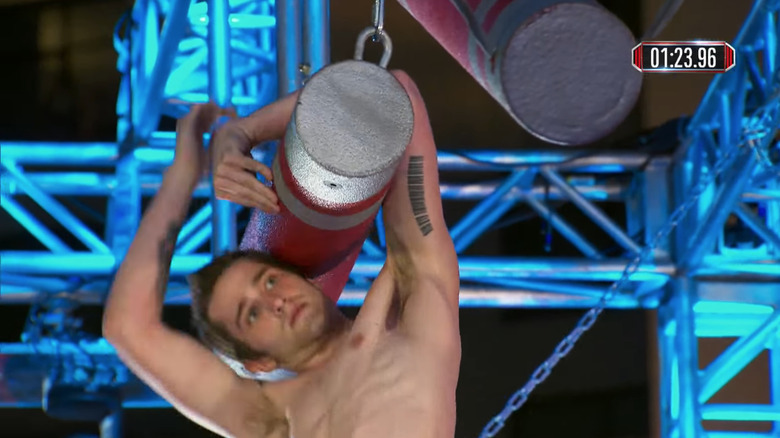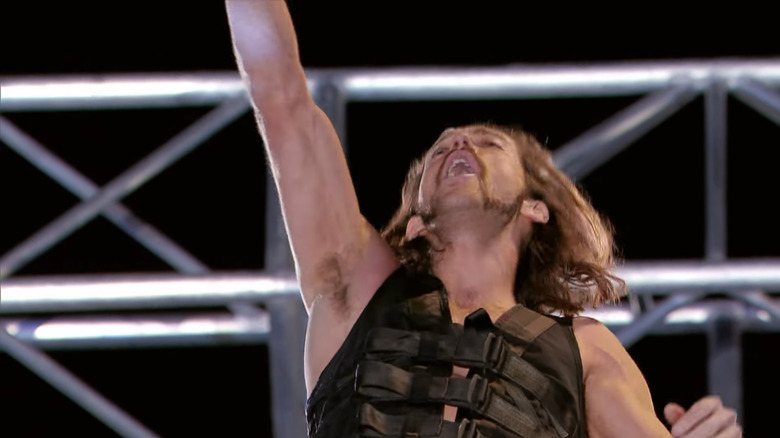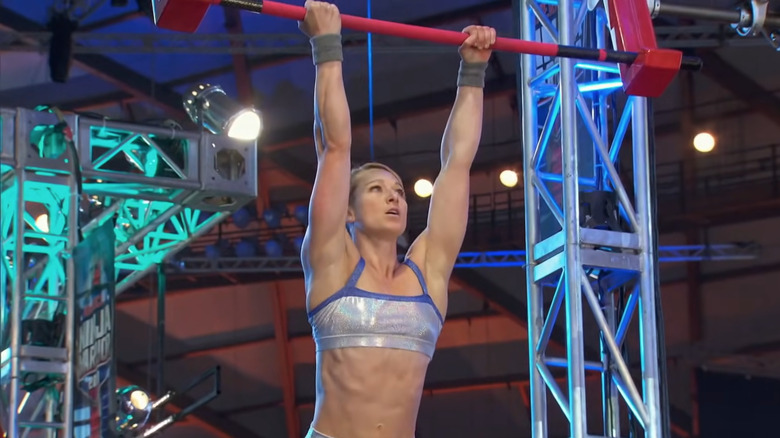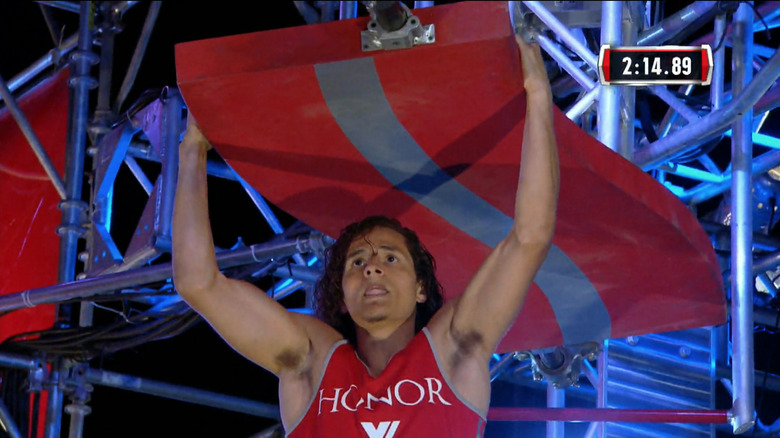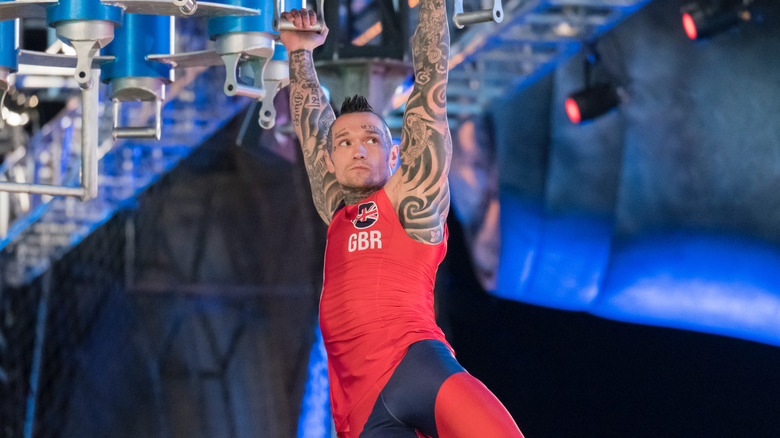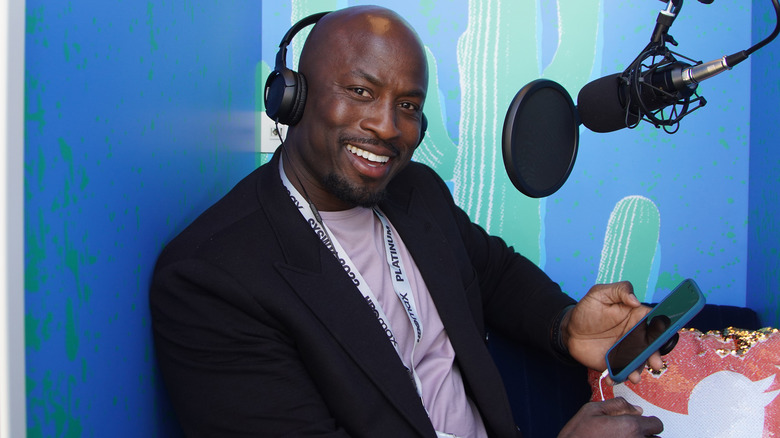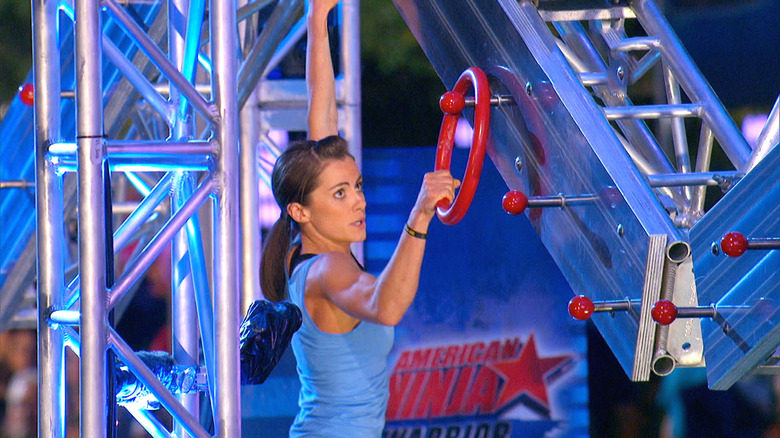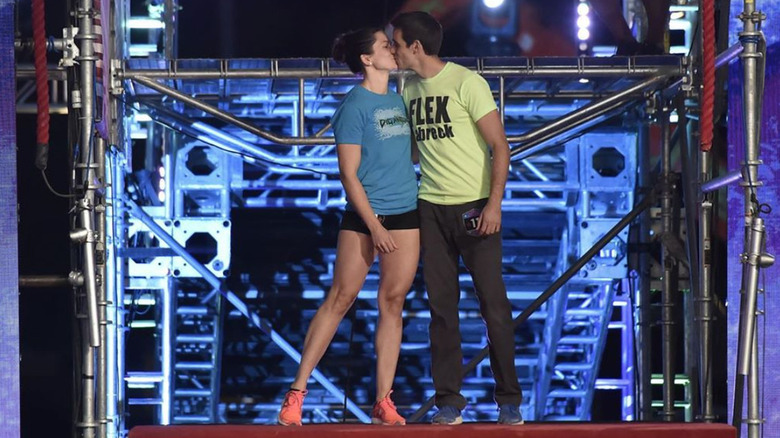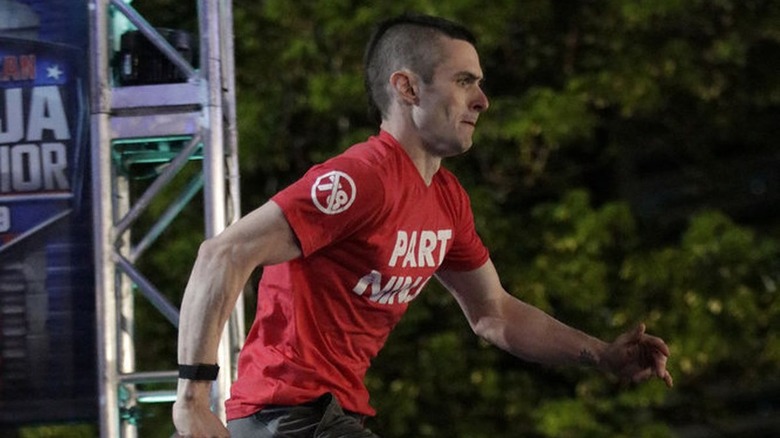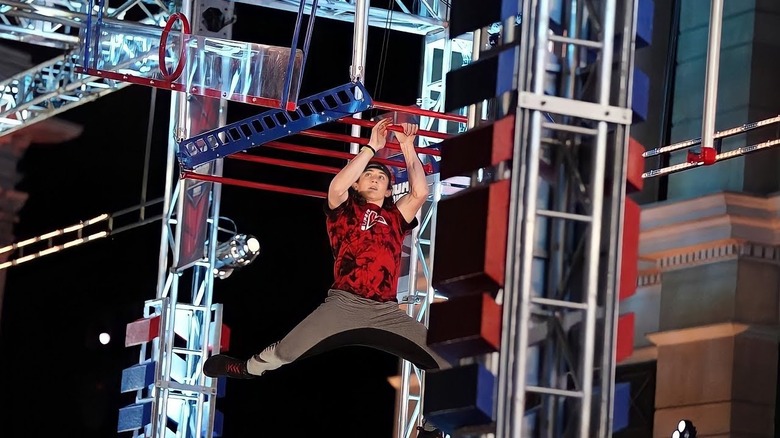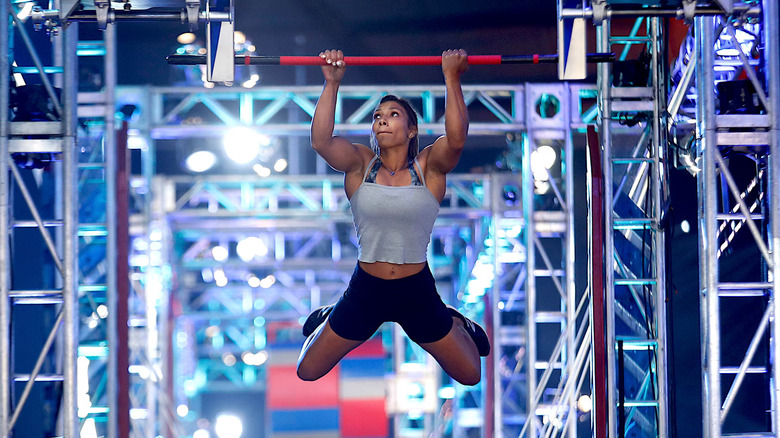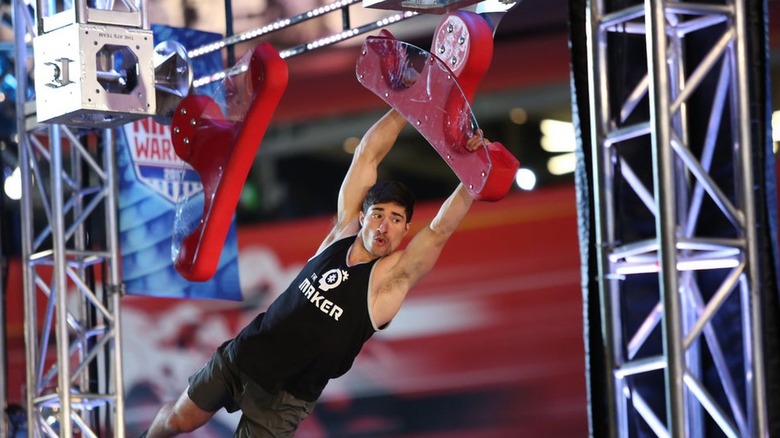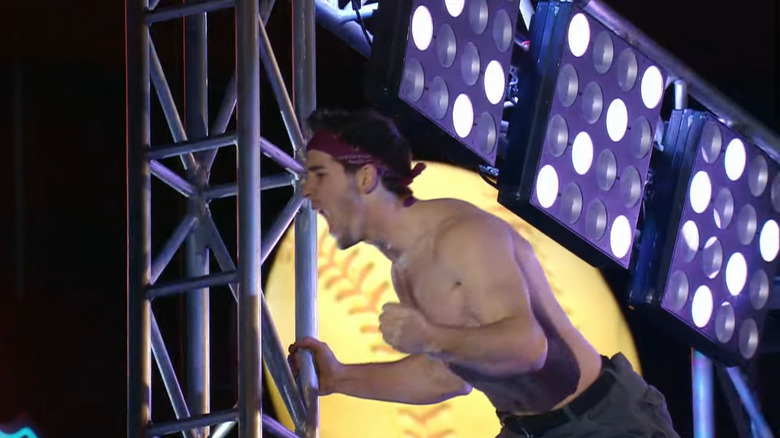The Untold Truth Of American Ninja Warrior
Each summer, audiences across America are treated to the ultimate beach bod motivator: "American Ninja Warrior," the obstacle competition show that's taken the world by storm. The show exhibits the best of what athletes can be, showing off a new, exciting sport that takes contestants to their physical limits. Climbing, swinging, and leaping through the show's obstacles, including notorious mainstays like the Warped Wall and the rope at Mount Midoriyama, contestants try to be the one to take home the $1 million grand prize. Most don't make it, and the show has, to date, only seen three competitors actually make it to the final finish line.
"American Ninja Warrior" has a long and storied history, and even super-fans might not realize just how far the show has come since it first aired — and just how much goes into making it the epic production it is today. This is the untold truth of "American Ninja Warrior."
It's adapted from a Japanese game show
Early seasons of "American Ninja Warrior" were very, very different. It was initially known as "American Ninja Challenge," a video submission series in which contestants submitted videos of themselves on ninja obstacles, with the ultimate goal of competing on the Japanese game show "Sasuke."
In those early seasons, contestants competed in one city qualifying course in Venice Beach; the top 30 moved onto the city finals, where they entered a "boot camp" that whittled them down to just 10 Ninja finalists, who traveled to Japan to compete on "Sasuke." Although the format was different, there were still some familiar Ninjas competing, including James McGrath, Drew Drechsel, Brent Steffensen, and Flip Rodriguez.
This all changed in Season 4, when the show started airing on both G4 and NBC, resulting in an increasing number of city qualifiers and a Las Vegas-set Mount Midoriyama. Without the Japanese version of the game show, ninja competitions likely never would have become popular enough to air on a major American network — and we never would have had "American Ninja Warrior."
The show had a long journey to primetime
"American Ninja Warrior" didn't get its start on NBC — the show started out on G4TV, a network within the company's cable group. That channel doesn't exist anymore (it went off the air at the end of 2014), but it provided a home for "American Ninja Warrior" for its first three increasingly popular seasons. According to host Matt Iseman, G4 went to NBC during the third season and offered to allow them to air the finale for free. "'Just air it on NBC to tell people G4 exists,'" Iseman, in an interview with GQ, recalled execs saying.
At the time, the network change was written about in outlets like The New York Times. The show was a relatively new concept, which the Times called "addictive," highlighting its "profoundly un-American" premise that if nobody completes all the challenges, nobody wins. The publication also pointed out that in those days, when the show was solely focused on sending Americans to Japan to compete on "Sasuke," the show was a success — four out of six competitors who reached the end of the course in Japan in 2011 were Americans. In previous seasons of "Sasuke," only one other American had managed that feat.
So the show had swapped networks, and with little to no promotion, the mostly unheard-of obstacle course series ended up winning the ratings for the night, leading to a permanent relocation for "American Ninja Warrior" in Season 4.
Matt Iseman has a very interesting background
"American Ninja Warrior" fans know that show co-host Matt Iseman is the man responsible for the signature drawn-out pronunciation of the show's title. However, many don't realize that he had quite an interesting life before taking his place at the podium.
Before becoming a TV personality, Iseman graduated with honors from Princeton University and earned his medical degree at the Columbia College of Physicians and Surgeons. He did his residency in internal medicine at the University of Colorado and was a practicing doctor before he decided to leave the medical world and take a shot at his true passion: comedy. As a comedian, he performed at the 2002 Salt Lake City Winter Olympics and traveled the world with the USO before hosting "Sports Soup" and ultimately joining "American Ninja Warrior" in its second season, replacing "Road Rules" cast member Blair Herter as the primary host.
The hosts can't actually see the contestants running the full course
It may sound like the hosts of "American Ninja Warrior" are right there in the moment, but in reality, the way the course is set up makes it so that they can't always see the first few obstacles. Instead, Iseman told Reality Blurred, the hosts watch on monitors, which also give them close-up views of the obstacles they can see, letting them provide more accurate commentary about minute details like hand placements and grips.
"On a typical course, we usually can't see the first or second obstacle," Iseman said. "We can then see most of them up to the warped wall and then we'll have monitors in front of us." For the obstructed obstacles and close-ups, he said, "We're watching the monitor trying to get a better sense of it, particularly on stuff where it's hand placement — where's their grip going? But usually we can see most of the course." Don't worry — the hosts at least get a full view when contestants reach the top of the Warped Wall.
Quite a few celebrities have competed
"American Ninja Warrior" held its first celebrity competition as part of NBC's Red Nose Day in 2017, allowing the likes of "Arrow" star Stephen Amell and "Dancing with the Stars" dancer Derek Hough to take on the course (albeit with some loosened rules). NBC then brought the special back in 2018, with co-host Akbar Gbajabiamila even joining in on the runs for charity. While Nastia Liukin, Natalie Morales, Nikki Bella, Jeff Dye, Mena Suvari, Nick Swisher, and Ne-Yo were among the other celebrities involved in the two specials, they weren't the first celebs who've seen if they have what it takes to be Ninjas.
Other stars who've taken on the "American Ninja Warrior" course throughout the years include "Survivor" contestants, actors, Olympians, and professional athletes from Globetrotters to MMA fighters. Repeat appearances have included race car driver Jade Buford, professional poker player Tony Miles, wakeboarder Shaun Murray, and former NFL players Andrew East and Kamerion Wimbley.
One of the most persistent celebrity competitors is Olympic silver medalist gymnast Jonathan Horton, who competed in three separate seasons between 2014 and 2021. Despite his valiant efforts, though, he's never made it to the National Finals in Las Vegas.
A Supergirl stuntwoman made history
Jessie Graff has doubled for a superhero on TV — and she's basically a real-life superhero too. Graff, who worked as a stunt double on multiple episodes of the CW's "Supergirl" and even appeared on camera in a small role in one Season 2 episode, made history on the course in the summer of 2016 when she became the first woman to complete Stage 1 in Las Vegas (this after coming in second in her city qualifier and being just one of two competitors to complete the Wedge obstacle).
A veteran of several of the show's seasons, Graff has popped up as a stuntwoman in a whole bunch of your favorite TV shows and movies, including "Live Free or Die Hard," "Heroes," "Iron Man 2," "Bridesmaids," "X-Men: First Class," "Transformers: Dark of the Moon," and "Agents of S.H.I.E.L.D." In 2020 she had the privilege of appearing in "Wonder Woman 1984," as both an Amazonian warrior and stunt double for Wonder Woman herself, Gal Gadot. Graff said stunt-performing in "Wonder Woman" is a "dream job." The stuntwoman is also well-known for her real-life staging of the famous "Family Guy" chicken fight, which has over 1.9 million views on YouTube.
A lot goes into making the obstacles
It seems like a no-brainer that quite a lot of planning and work goes into setting up the elaborate obstacles of "American Ninja Warrior," but it's interesting to see just how deep the process goes.
The whole course is the size of a football field, while Las Vegas' Mount Midoriyama is the size of four football fields — a lot of real estate to fill up with new challenges. Producer Brian Richardson said planning the obstacles takes months of brainstorming, with some ideas starting as something someone sketched on a napkin. From there, they figure out the course on paper before building a prototype and testing it in a warehouse. If it passes, it makes it to the course, but the testing isn't done yet — even more people test the course to make sure the difficulty is at the right level. "Moving a rope 6 inches closer or farther away can make a world of difference," Richardson said (via Mental Floss).
Apparently, producers have a set goal of around 20 percent of contestants finishing the city qualifiers, meaning that they test and test and test new obstacles until they find about 24 to include. Contestants don't know which obstacles they'll face going in, and they're not allowed to try out the course before their official run, so it's on them to figure out in the moment how to keep up with whatever producers throw at them.
The obstacles are usually ordered in a certain way
The obstacles are also ordered in a certain way, something frequent observers of the show may notice as they watch. According to the people responsible for designing the challenges, this is done on purpose to provide some structure. The first obstacle is always some variation of the steps — usually four pads the contestants can either run or jump across. The second obstacle, co-executive producer Anthony Storm told Men's Journal, is a not-too-hard upper-body challenge used to separate "the athletes from the wannabes." As he puts it, "Almost everyone can physically get past the second obstacle, but if you're nervous, you're probably going to fail it."
The other obstacles tend to focus on skills like balance, upper body strength, and speed. The third obstacle, for instance, is usually balance-based, while the fifth once again focuses on upper body strength. The qualifying course always ends with the Warped Wall, while the Salmon Ladder always places eighth when moving on to the city finals.
You can volunteer to be an obstacle tester
Have you ever wanted to run the "American Ninja Warrior" course, but don't want to take a splash on TV? You're in luck. The night before each city's run, a group of volunteers is chosen for the chance to let producers know if they need to make any last-minute adjustments. There's no money involved, but they get the chance to run the course and test their ninja skills without all the pressure.
Volunteers to be "American Ninja Warrior" course testers come from a number of different walks of life, including prospective contestants who sent in a tape to audition for the show but didn't make the cut, professional stuntmen, and regular people who work out at local gyms. According to past testers, you can visit the set around the time of filming to see if they need any testers, or you can email the casting team if you want to try out. (Another bonus? If you test out the course, they let you come back for the taping for free.)
Filming happens at night
Up until Season 5, "American Ninja Warrior" contestants competed during the day, but since then, filming has happened at night. Tapings in each city begin around 8 p.m. and go into the wee hours of the morning, with some contestants doing their runs around 3 or 4 a.m. Even contestants who run earlier in the night can stick around that late if they're waiting to find out whether they made it into the top 30 or 15, especially those who are on the edge. This is obviously quite taxing on contestants, adding a whole new layer of difficulty to an already grueling show.
Another thing making the show harder for contestants? They film regardless of the weather, which means that even if it's raining or cold — so long as it's still safe — contestants are still expected to head out on the course and show those obstacles what they've got.
The cities have to do a lot of planning for the show
Bringing a football field-sized obstacle course into the middle of a crowded city for multiple nights of filming is no easy task. Road closures, permits, and security are required, meaning it can be quite a headache for the cities that volunteer.
However, there are also a lot of benefits, with the show known to provide an economic boost during its time in the area. Although it's tough to figure out exactly how much business the show brings into the city, it usually comes with hundreds of booked hotel rooms for the show's crew, the Ninjas, their families, and fans, as well as increased foot traffic.
Because of this, many cities pitch "American Ninja Warrior," letting the show know why they'd be a good place to visit. Often this comes with a state tax credit that helps lower production costs; some cities also incentivize the show by offering them a free permit to film in a prominent location.
The show doesn't just cast for athletic ability
Being a great athlete doesn't guarantee you a spot on "American Ninja Warrior." While the show obviously puts quite a lot of effort into finding contestants who are able to compete, there are a lot of other factors that go into casting.
To apply to be on "American Ninja Warrior," contestants have to submit a long online questionnaire as well as submit a video of themselves. The video is where contestants have to really let their personality shine, convincing the casting directors that they won't just be able to complete the course, but that they'll also be fun to watch while they do it. As with most reality shows, the "Ninja" casting directors are looking for contestants with interesting stories who will inspire viewers both on and off the course.
Contrary to contestants on a lot of other reality shows, though, most "American Ninja Warrior" hopefuls who make it say that they feel they were portrayed fairly and accurately, with one contestant saying the crew spent the entire day with him just to get his two-minute introductory video perfect.
Isaac Caldiero's win was very controversial
Geoff Britten became the first man to reach the top of Stage 4 in Vegas in Season 7 of "American Ninja Warrior," but he didn't end up with the $1 million prize — instead, that went to Isaac Caldiero, the second man to finish, who topped the rope in just under four seconds less than Britten. The fact that Britten walked away empty-handed caused a lot of upset among "American Ninja Warrior" fans, especially considering that Britten finished every single course, while Caldiero did not, failing in the penultimate obstacle of the Kansas City finals but still qualifying to move on to Las Vegas due to his fast time.
Britten took the results in stride for the most part, but many fans (and some of his fellow Ninjas) did not. Some fans even set up a GoFundMe account to give Britten his $1 million; while it didn't come anywhere near reaching that lofty goal, it did raise $14,000.
Since the controversy, the show has made several adjustments to its formula. In Season 8, for example, the rules were changed so that multiple finishers of Stage 4 would split the top prize. Then in Season 10, the show introduced the $100,000 prize for Last Ninja Standing – the competitor who goes the furthest the fastest, regardless of whether all the stages are completed.
Being a Ninja is basically a full-time job
Many Ninjas have to quit their day jobs if they want to get serious about competing. Because being an elite-level Ninja is basically like being a pro athlete, Ninjas are finding new ways to make a living based on their athleticism, rather than through traditional jobs. This includes doing commercials and making appearances at gyms and other events. A high percentage of Ninjas also own their own Ninja gyms, which have popped up all over the country as the popularity of the sport increased.
However, some Ninjas are still pushing for more, with many believing that the future of the sport may eventually lead as far as the Olympics. For now, however, the main concern is compensation for athletes. While the show has the $1 million prize (which only two people have won thus far), early seasons didn't offer much else. It wasn't until after the Season 7 controversy that the show instituted the $100,000 prize for Last Ninja Standing and small monetary prizes for top city finals finishers. Additional changes like the $10,000 Mega Wall bonus (given to any qualifying athlete who reaches the top of an 18.5-foot warped wall in a single attempt) and the Safety Pass (offering qualifying athletes a mulligan on Stage 1 or 2 of the finals course) have increased the show's appeal to contestants. However, the show will have to continue to evolve and update its rules for compensation and sponsorships in order to keep the athletes coming back.
You can train like an American Ninja Warrior too
"American Ninja Warrior" has gotten a lot more popular — and so have Ninja gyms. Once a specialty business, these gyms let people train using the same type of obstacles and techniques they see in the show. The gyms began to pop up all over the country as regular people began to want to take a shot at the course and have become a cottage industry all their own.
The increasing trend of Ninja gyms has resulted in more applications for the show, which saw 50,000 people apply for Season 7, up from just 5,000 for Season 6. This has also resulted in competitors like Josh Levin and Daniel Gil, who trained for years at Ninja gyms waiting until they were old enough to get on the show. If you've ever wanted to take a shot at the course, look around for your nearest Ninja gym and start practicing.
American Ninja Warrior spawned a number of spinoffs
The success of "American Ninja Warrior" has led to quite a few spinoffs, including specials like "Celebrity American Ninja Warrior," "Family Ninja Warrior," the women's ninja championship, and "USA vs. the World." There have also been full-fledged shows like "Team Ninja Warrior," which teams up some of the show's alums for three-people competitions; and "American Ninja Warrior Junior," which ran for four seasons and allowed kids ages 9 to 14 a chance to compete.
There are also similar competitions like "Spartan: Ultimate Team Challenge" — executive produced by "American Ninja Warrior" producer Kent Weed — which brought in teams of athletes for a difficult race, with four people serving under an elite captain. The show was often paired with "American Ninja Warrior" on NBC's summer schedule, providing a whole night of athletic fun.
"American Ninja Warrior" has also spawned a few copycats — most notably Netflix's "Ultimate Beastmaster," in which contestants run an obstacle course called "The Beast." The show uses a very similar format to "Ninja Warrior" and features similarly difficult types of obstacles; however, unlike "American Ninja Warrior," "Beastmaster" always crowns a winner in the end.
Akbar Gbajabiamila is more than a former athlete
Matt Iseman's cohort in the "American Ninja Warrior" commentator's box is former NFL linebacker Akbar Gbajabiamila. The transition from professional athlete to sports analyst is a common one, but this Los Angeles native son of Nigerian immigrants has a boisterous enthusiasm that makes him a joy to watch, and his quick analysis of Ninjas' runs on the "American Ninja Warrior" course provides excellent insight.
One reason for that insight and enthusiasm — beyond his life as a dedicated athlete — might be that Gbaja-Biamila himself once appeared as a reality contestant. "Expedition Impossible" aired in 2011 on ABC and featured 13 teams of three in a format very similar to "The Amazing Race," with teams traveling together to various checkpoints, completing challenges, and racing to the end. Prior to hosting "American Ninja Warrior," Gbaja-Biamila worked for NFL Network, and now he splits his "Ninja" time as co-host of "The Talk" on CBS, putting his communication degree from San Diego State University to good use. In addition, he holds a certificate from the Wharton School of Business and became a published author in 2019 with his motivational book "Everyone Can Be a Ninja."
His charitable service includes providing poverty-stricken communities with more education opportunities, improving the life skills of Southern California youth, and advocating for Parkinson's research as part of the Michael J. Fox Foundation — an organization near and dear to his heart after his father's own Parkinson's diagnosis.
Zuri Hall breaks the mold of sideline reporters
Several women worked as sideline reporters for "American Ninja Warrior" over the years, and Zuri Hall joined the team in 2019 and broke the mold. Hall worked local television news before turning her talents to hosting in a variety of venues, from the NBA to the Thanksgiving Day Parade. She went on to work for E! in several capacities in addition to MTV, VH1, BET, and others. Now she reports for "Access Hollywood" and co-hosts "AllAccess" in addition to her "American Ninja Warrior duties," where her emotional, supportive coverage is a huge asset.
Sideline reporters are often seen as simply eye candy, but Hall earned a full academic scholarship to The Ohio State University for her entire four-year tenure and now holds a degree in strategic communication. She also minored in theater, and to hone those spontaneous live on-air skills, she studied with the improv group Upright Citizens Brigade, the former playing ground of Amy Poehler and other "Saturday Night Live" cast members.
Hall uses her celebrity to support Black women, racial justice, and underprivileged communities, and her advocacy is a feature "American Ninja Warrior" embraces. Unlike most competition reality shows, "American Ninja Warrior" is a huge supporter of charitable work and contestants quite literally often wear their causes on their sleeves. Hall loves being a part of the "American Ninja Warrior" community and its persistent emphasis on conquering obstacles in life, as well as on the course.
The first woman to break the Ninja glass ceiling is now a pro wrestler
When 5-foot-tall Kacy Catanzaro reached the top of the Warped Wall of a 2014 "American Ninja Warrior" qualifying course in Dallas, she made history as the first woman ever to complete a qualifying course on the show. When she completed the Dallas city finals course a few weeks later, a movement was born. It was known as the Kacy Effect, and it culminated in hundreds of women taking up the sport and applying to compete on the show. No longer considered a good athlete "for a girl," Catanzaro opened the door to men and women being held to equal standards, on equal footing — at least in the network ninja obstacle course competition series. Elite athlete Jessie Graff, gym owner Jesse "Flex" Labreck, and personal trainer Michelle Warnky fought to be higher in the rankings than some of the most highly rated men to have been on the show.
Now, Catanzaro competes in a whole new arena as part of World Wrestling Entertainment (WWE). Through ups and downs as she transitioned into the sport, Catanzaro eventually paired with Kayden Carter as a tag team and not only won the championship, but retained it for a record-breaking 186 days. Wrestling is a big change from Ninja courses, but no matter what Catanzaro does from now on, she'll always be the woman who set a new standard for women in "American Ninja Warrior."
Love is in the air
Couples meeting on reality television is not a new phenomenon, but when they meet on "American Ninja Warrior," the bonds seem a little stronger. Take James "The Beast" McGrath and Allyssa Beird. The couple met through competing on the show and training together. Six years later, McGrath popped the question following his successful completion of the qualifying course after overcoming an injury. The moment was poignant and sweet, but also completely inspirational.
Then there's Chris DiGangi and Jesse "Flex" Labreck. Their relationship also started as a result of the show, and it's grown in front of the audience's eyes throughout the years. The two are loving and supportive of one another but also highly competitive. The two are so evenly matched that they often fall at the same obstacle, finish the Wall together, and run step for step when competing head to head.
In 2023 another "Ninja" love story came to light as the show revealed Caitlyn Bergstrom — one of the competitive Bergstrom siblings — and David Wright, "The Cake Ninja," were married in September 2022 after meeting at the Las Vegas Finals in 2019. Caitlyn's Ninja brother, Caleb, is also married to a fellow Ninja competitor, Ashley, and the foursome make training and competing together a family affair. The competition brings together people from all walks of life who share a similar love of fitness and competition, and these couples are beautiful examples of the connections possible when birds of a feather flock together.
Long walk-on lines replaced with lottery system
Early seasons of "American Ninja Warrior" were known for their days-long walk-on lines where contestant hopefuls would camp outside just for the chance to compete. Stars like Kevin Bull had unforgettable runs after coming on as walk-on contestants, and regular competitor Dave Cavanagh is known as "King of the Walk-Ons" because he made it to the show through that process for five straight seasons. Unfortunately, the process was cumbersome and often required prospective Ninjas to take weeks off work for only a slim chance to compete.
For Season 11, therefore, the process was changed. Instead of camping at taping locations — many of which did not allow such activity and considered it trespassing — contestants could enter themselves in a lottery at one of the qualifying cities. The lottery process was incredibly simple, consisting of no more than 20 names being selected from the entrants. Those 20 entrants were the successful walk-ons for that city, and anyone who didn't get on the show there could apply at one of the other locations.
This process is not only simpler — it's also more egalitarian, offering people from all walks of life and economic status the chance to test their skills at the biggest Ninja stage in America.
The age limit is a source of continued controversy
When "American Ninja Warrior" first landed on TV screens, contestants had to be at least 21 to compete. For 12 seasons, this was the case. Unsurprisingly, those in their early 20s were some of the strongest and fastest competitors, but the real inspiration came from a lot of the older contestants. Ninja has always been a sport that allows people of all ages to try their hands at the obstacles, and seeing older contestants like Sam Sann, David Campbell, Sandy Zimmerman, and Jon Stewart (not that one) competing in their 40s has consistently driven home the message that it's never too late to start your fitness journey and achieve incredible results. In 2018, however, the age limit was lowered to 19, and the focus of the show began to pivot to the younger Ninjas.
For Season 13, the age limit was lowered again and teens as young as 15 were invited to compete on the elaborate obstacle course. Obviously youth has always been a focus of television in general, but fans were evenly split on whether the lowered limit was a good idea or not. Many believed their younger, more flexible bodies would hold an unfair advantage. Others thought their lack of experience would be a disadvantage. However, the great success of some of these younger competitors — particularly Kaden Lebsack, who has been the Last Ninja Standing two years running — means the change is here to stay.
Pole vaulters, gymnasts, and rock-climbers hold an edge
Of the many "American Ninja Warrior" superstars, some of the most successful have had a previous history of excelling in other sports. Athletes who have trained to control their body movements in mid-air, such as gymnasts and pole vaulters, seem to hold a certain edge. Rock climbers, with their incredible grip strength, reach, strategic problem-solving, and ability to pace themselves for long climbs, have also landed among the elite "American Ninja Warrior" competitors. The show's first winners, for example, were rock climbers Geoff Britten and Isaac Caldiero, whose upper body strength, grip strength, and stamina served them extremely well on the courses.
Of those to attempt Stage 4, in fact, some of them are professional rock climbers — namely Sean McColl, Britten, Caldiero, and Josh Levin — and one, Travis Rosen, is a former gymnast. Furthermore, some of the best women to compete on "American Ninja Warrior" have also leveraged skills from these same areas. Jessie Graff is famously a former record-setting pole-vaulter, while Kacy Catanzaro and Barclay Stockett were both gymnasts. Meanwhile, rock climber Meagan Martin boasts pole-vaulting, competitive climbing, and gymnastics skills and utilized the combination of those skills and athletic prowess to become the first Women's Champion in 2021.
Some obstacles were designed by fans
In Season 8, "American Ninja Warrior" announced its Obstacle Design Challenge. Since then, 29 obstacles to appear across the stages have been designed by fans and fellow Ninjas. Four of them were designed by the same guy, Kevin "The Maker" Carbone. In Season 9, Carbone became the first designer to compete on his own invention, successfully completing the Wingnuts obstacle in Daytona Beach. Carbone was so successful at creating new obstacles, in fact, that it became his profession.
Carbone wasn't the only competitor to design new hurdles for the athletes to face. Fellow Ninjas Kevin Brekke, Josh Norton, Christian Youst, and Brett Sims have also submitted obstacles that appeared on the show. However, it doesn't require a Ninja to design a good obstacle. In Season 14, Tetherball premiered, having been designed by Stacie Harris, the oldest known entrant to win the design challenge (at age 50).
While the Obstacle Design Challenge was not announced for Season 15, new fan-designed obstacles are still premiering on "Ninja" courses. On Episode 3, contestants had to try to navigate the puzzling upper body obstacle, The Cubes, which felled even superhero Jessie Graff. The Cubes obstacle was designed by a 10-year-old fan from Ithaca, New York, named Grace, proving good ideas are ageless.
The show cut ties with its most popular athlete
Dubbed the "Real Life Ninja," Drew Drechsel was an "American Ninja Warrior" phenom. A freerunner and gym owner, Drechsel had competed on the show every year since Season 4. He was known for fast times and great finesse and was easily one of the show's favorite personalities. After years of competing, Drechsel finally won the distinction of Last Ninja Standing in Season 10 and was a grand prize winner in Season 11.
In 2020, however, news broke that Drechsel had been arrested on various charges of illegal sexual contact with a minor. The charges were supported by several explicit pictures in Drechsel's possession of the minor in question. "American Ninja Warrior" wasted no time in responding to the charges, permanently severing all ties with Drechsel and editing him out of episodes that had yet to air. In a statement quoted by NBC News, a spokesperson for the show said, "We will not let the actions of one contestant tarnish the hard work and amazing stories of so many," emphasizing the family-focused and positive nature of the competition.
On June 1, 2023, Drew Drechsel entered into a plea deal encompassing pleading guilty to two charges that could result in up to 60 years in prison and would require registration as a sex offender.
If you or anyone you know has been a victim of sexual assault, help is available. Visit the Rape, Abuse & Incest National Network website or contact RAINN's National Helpline at 1-800-656-HOPE (4673).
